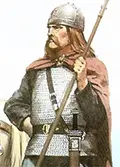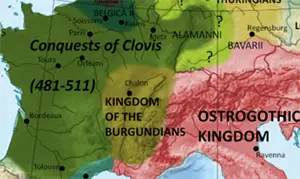The Burgundians
Like some other Germanic tribes, the Burgundians migrated from southern Scandinavia (many sources say from the island of Bornholm) into central Europe. The Roman historian Tacitus in his book Germania mentions the Burgundians as living in what is now Poland at the end of the 1st Century. In 277, a group of Burgundians and members of another tribe, the Vandals crossed the Rhine and invaded the Roman Empire. The Romans under the emperor Probus defeated the invaders, captured a great number of them, and shipped them off to Brittania. 
In 406, the River Rhine froze. Suddenly, it was much easier for people to cross the great river. A large group of Germanic tribes did so, among them a man named Gundahar (sometimes written Gunther), who led his people to settle on the western side of the river. This was the foundation of the Burgundian Kingdom. Gundahar was powerful enough at this time to hold sway over the Roman throne and installed on it Jovinus, a Senator who reigned for two years in the wake of the defeat of another usurper, Constantine III. (Both of those usurpers were co-emperors with Honorius, whose defeat in internecine battles forced him to share power.) 
The three other main cities of this kingdom were Speyer, Strasbourg, and Worms. They later led raids into the Belgian province of Gaul. Gundahar's son, King Gundioc, had built a settlement at Lugdunum (what is today Lyons) and was an ally of Flavius Aetius, who famously defeated Attila the Hun. (One group of Burgundians who did not cross the Rhine originally did so later, as part of Attila's army.) Like many others, the Burgundians suffered from attacks by the Huns and appealed to Rome for protection. Gundahar and a great many Burgundians died at the hand of the Huns, in 437; Worms, as well, was destroyed. The remaining Burgundians, led by Gundahar's son Guneric, convinced Rome to let them stay within Roman borders. They settled near Lugdunum (now Lyon) and had a new capital at Vienne. In exchange, the Burgundians agreed to fight for Rome, and many Burgundians fought alongside Aetius and the Visigoths against the Huns at the Battle of Chalons in 451. The Burgundian king Gundobad was commander of the Roman army in the 470s. He was also well-known as King of Burgundy, having worked out an alliance with the Franks by agreeing to marry his niece to the Frankish king Clovis. The Burgundians continued to play a part in a seemingly never-ending parade of weaker and weaker Western emperors. 
In 490, Gundobad led the Burgundians on a well timed raid into Ostrogoth territory, seizing land that was sparsely defended because of the Ostrogoths' war with the Byzantine Empire. Also during this time, the Burgundians completed a law code, putting together Germanic and Roman laws. Gundobad's sons ruled after him, first Sigismund and then Godomar. The latter took charge of the reins of government. He held them for more than a decade, in the process defeating a Frankish army at Vezeronce in 524. Godomar died in 535, in the middle of a battle against the Franks, which the Franks won. |
|
Social Studies for Kids
copyright 2002–2024
David White




